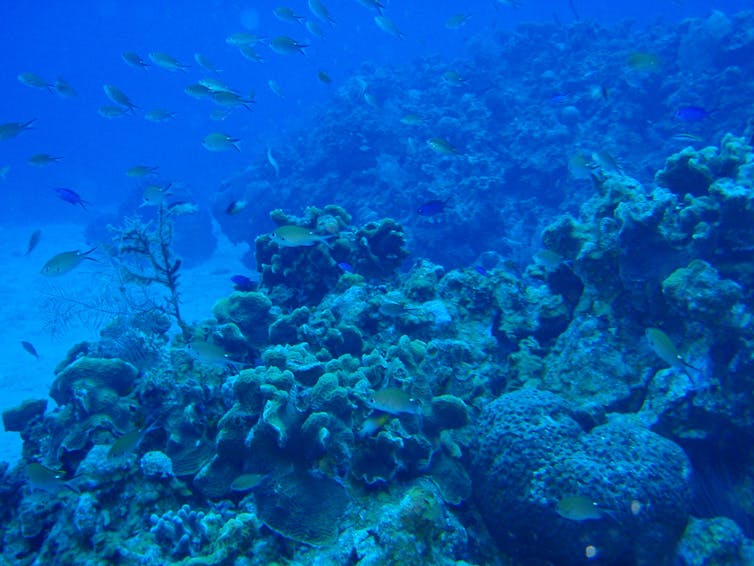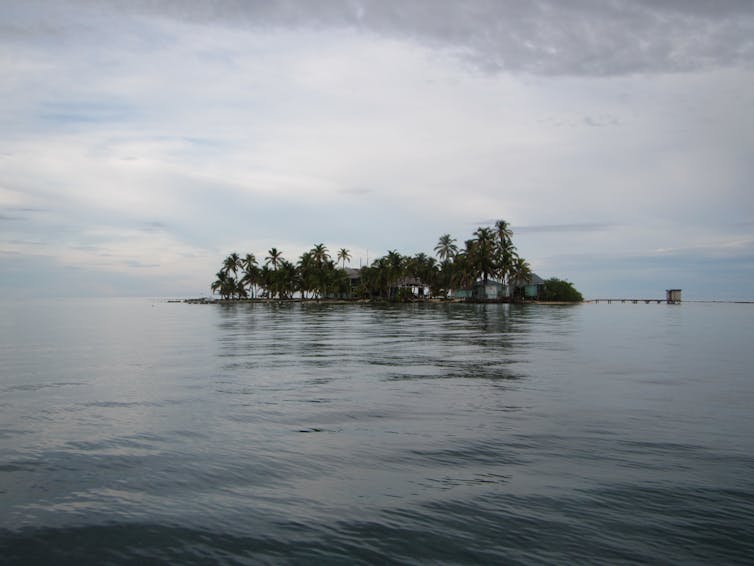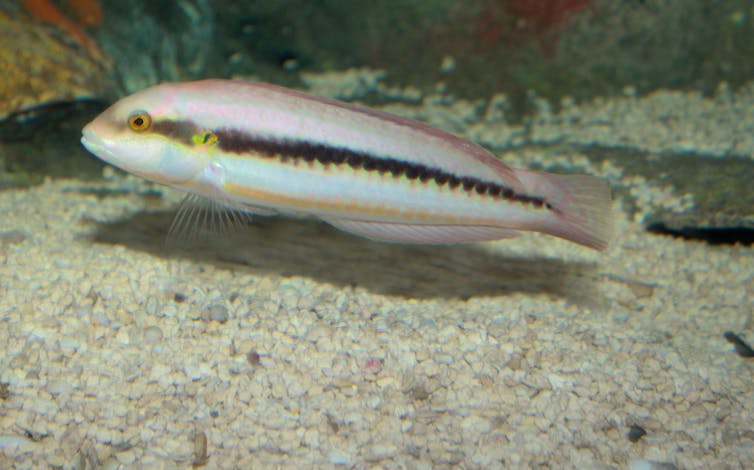We found algae-farming fish that domesticate tiny shrimp to help run their farms
- Written by William Feeney, Postdoctoral Research Fellow in Evolutionary Ecology, Griffith University
Humans are experts at domesticating other species and our world would be unrecognisable without it. There would be no cities, no supermarkets, and no pets. Domestication is a special kind of cooperative relationship, where one species provides prolonged support in exchange for a predictable resource.
While humans have domesticated various plants and animals, these relationships are surprisingly rare in other species. It’s true some insects (ants, beetles, and termites among them) domesticate fungi, but few other examples exist outside the insect world.
In our new study, we describe what appears to be first example of a non-human vertebrate domesticating another animal.
 On the coral reefs off the coast of Belize, in Central America, longfin damselfish create, manage and feed from algae farms.
By Andy Blackledge - P4120130, CC BY 2.0, CC BY
On the coral reefs off the coast of Belize, in Central America, longfin damselfish create, manage and feed from algae farms.
By Andy Blackledge - P4120130, CC BY 2.0, CC BY
Read more: Listen up: many farmed fish are hard of hearing – here's why it matters
Farming fish domesticate shrimps
On the coral reefs off the coast of Belize, in Central America, longfin damselfish create, manage and feed from algae farms. We noticed they regularly have “swarms” of tiny crustaceans called mysid shrimps floating above their farms.
We found this unusual, as most farming damselfishes chase away anything that ventures near their farm. We were unsure why these species associated with one another, so we decided to try to find out what was going on.
First, to see whether mysid shrimps and farming damselfish are regularly found together, we ran a series of what’s known as “transects”. In other words, we conducted a series of 30 metre swims along the reef, and during each one we recorded each time we saw mysid shrimps, as well as whether they were near farming damselfish or other fish species.
We found these mysids were far more likely to be found near farming species, like the longfin damselfish, than other species.
 The Smithsonian’s Carrie Bow Cay Marine Research Station off the coast of Belize.
Rohan Brooker
The Smithsonian’s Carrie Bow Cay Marine Research Station off the coast of Belize.
Rohan Brooker
Next, we wanted to know if the mysids specifically seek out their damselfish partners.
So, we collected mysid shrimps from the field, brought them into the lab and exposed the mysids to water soaked with different things. For example, do they avoid the smell of a predator? Are they attracted to the smell of a farming damselfish?
We found the mysids shrimps were attracted to the longfin damselfish, repulsed by a predator and indifferent towards a non-farming fish — and to the farm itself.
I help you, you help me
Many fish eat mysid shrimps, so we ran an experiment to see if longfin damselfish provided protection to the mysids when they are in the fish’s farm.
To do this, we placed mysid shrimps in a clear plastic bag and placed the bag either inside or outside a farm.
We found that when placed outside a farm, other fish tried to eat the mysid shrimps. When inside the farms, any fish that tried to come close to the bag was chased off by the longfin damselfish. This suggested the mysids seek out longfin damselfish, as they provide mysids with protection from predators.
 Slippery Dick Wrasse is a common predator of mysid shrimps.
Brian Gratwicke/Flickr, CC BY
Slippery Dick Wrasse is a common predator of mysid shrimps.
Brian Gratwicke/Flickr, CC BY
One question remained: do the mysid shrimps provide a benefit to the longfin damselfish?
Given the damselfish eat the algae they farm, we thought maybe by hovering above the farm, the mysid shrimps waste might act as fertiliser.
To test this, we examined the quality of the algae within farms that did, or did not have mysid shrimps. We also examined the body condition of fish that did, or did not, have mysid shrimps within their farms.
We found farms with shrimps had higher quality algae, and fish from farms with mysid shrimps were in better condition.
Insight into how domestication happens
These different analyses together suggest longfin damselfish have domesticated mysid shrimps. The longfin damselfish provide a safe refuge, and in exchange the mysid shrimps provide the damselfish with fertiliser for its farm.
This relationship is important, because while fantastic research has provided insight into the history of domestication in our ancestors, these things happened in the distant past.
In the longfin damselfish, we can watch the early stages of domestication occur as it’s happening.
This is fascinating because it’s very similar to the proposed series of events that led to our domestication of species such as chickens, cats, dogs and pigs.
Read more: It might be the world's biggest ocean, but the mighty Pacific is in peril
Authors: William Feeney, Postdoctoral Research Fellow in Evolutionary Ecology, Griffith University



